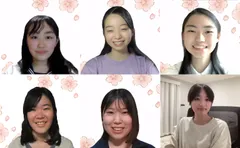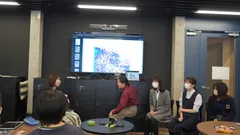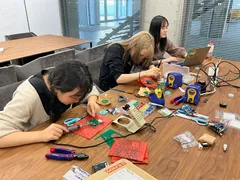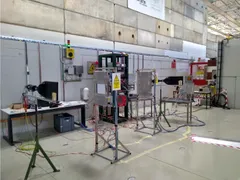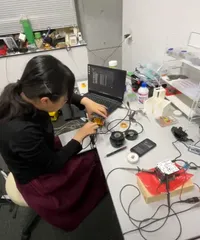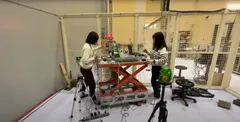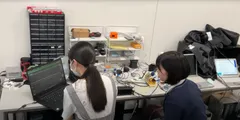First Japanese High School Girl's International Elementary Particle Experiment Adopted in Geneva, Switzerland
加速キッチン合同会社
Sakura Particles, a team of Japanese high school girls supported by Accele Kitchen, LLC, has been selected as the first Japanese team to propose a particle experiment for high school students at CERN (Switzerland), the world's largest accelerator facility.
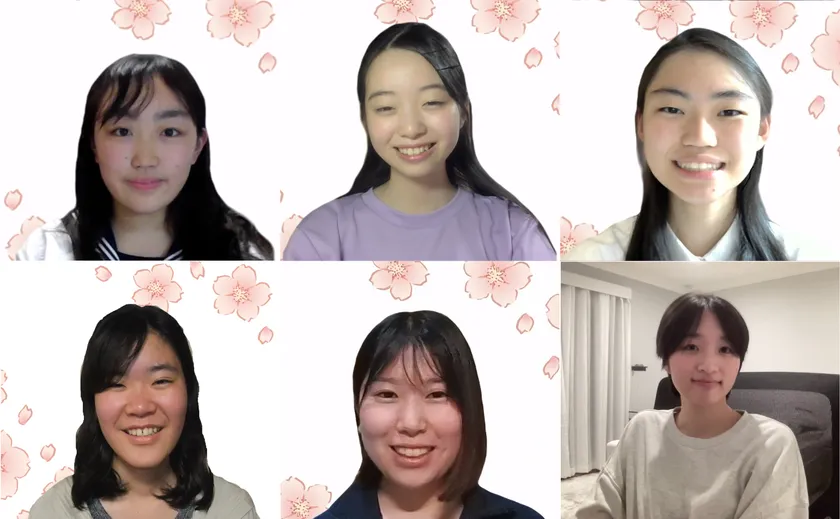
Sakura Particles high school students and graduate student coach
■Outline
Beamline for Schools at CERN, the world's largest accelerator facility in Geneva, Switzerland, accepts particle experiment proposals from high school students around the world every year, and Sakura Particles, a group of Japanese high school students, was successfully selected from a record 461 proposals. This is the first time that Japanese junior and senior high school students have conducted particle experiments at a large accelerator facility.
Sakura Particles is a team of high school students fromJoshigakuin Senior High School, Saitama Prefectural Kawagoe Girls High School, Osaka Prefectural Kitano High School, Kanagawa Prefectural Kawawa High School, and Junten High School. The team developed a "handmade cosmic ray imaging device".
The detector they developed is a "handmade cosmic ray imaging detector. The goal is to apply this detector to muography, a technique that uses high-energy muons from space to see through the interior of large structures on Earth.
Such imaging detectors are generally large and expensive, but the team of high school students has succeeded in developing a handmade detector that measures the trajectory of muons with their own unique ingenuity. Furthermore, in March 2024, for the first time ever for a high school student, the team conducted a test using a light-speed electron beam at the High Energy Accelerator Research Organization's Photon Factory to demonstrate its performance. These achievements were internationally recognized and resulted in the adoption of the project this time.
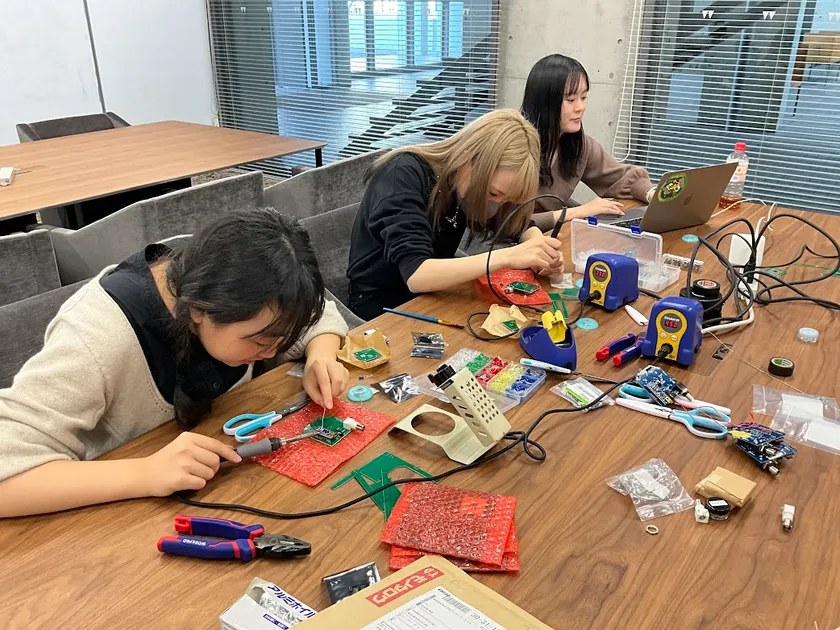
Members fabricating detectors
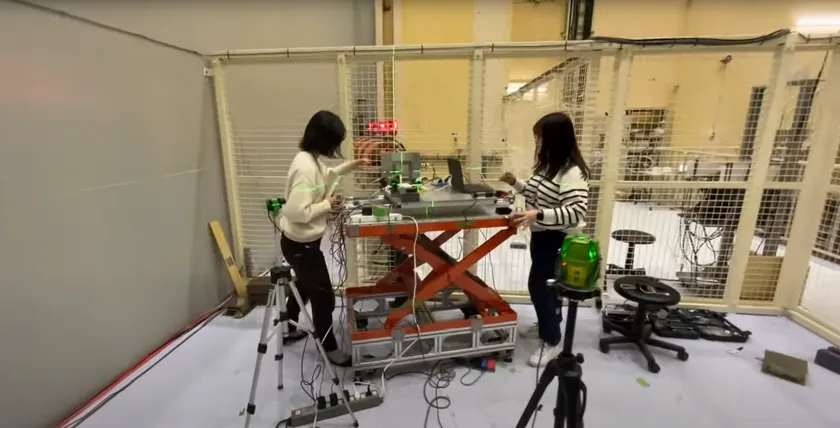
Beam test at High Energy Accelerator Research Organization (KEK)
At CERN, the imaging performance of the self-built detector will be tested by generating an artificial high-energy muon beam that simulates cosmic rays falling from space at more than 99% of the speed of light. The experiment will be carried out with the support of particle physicists at CERN.
What is the Accel Kitchen?
Accel Kitchen supports junior and senior high school students who are engaged in space and particle exploration activities. We lend them particle detectors so that they can measure cosmic rays at home, and provide online mentoring by university student mentors to enable them to make realistic measurements of elementary particles. Sakura Particles is a team formed by volunteers from these participating junior and senior high school students.
Sakura Particles
Chiori Matsushita (Joshigakuin Senior High School)
She has been observing cosmic ray showers to search for high-energy cosmic rays since she was a second-year junior high school student.
- Selected for JSEC2023 (Search for ultra-high energy cosmic rays using Cosmic Watch, a small cosmic ray detector)
- Student Web writer, RIKEN Nishina Center for Accelerator-Based Science
https://www.nishina.riken.jp/ouen/report6.html
Mihiro Nukiwa (Saitama Prefectural Kawagoe Girls' High School, High School Graduate)
Since her first year of high school, she has been conducting research on dose distribution measurement during cancer treatment with proton beams, focusing on simulation. 2023, she formed Sakura Particles and entered the Beamline for Schools 2023 shortlist.
- High School Radiation Class 2022 Incentive Award (Visualization of dose distribution using scattered protons)
Manami Sawai (Kanagawa Prefectural Kawawa High School, senior high school student)
Since the first year of high school, she has been developing an automatic imaging and classification function of radiation passing through a detector by combining a fog box and a detector.
- Science Castle 2022 Kanto Competition Excellence Award (Observation of cosmic rays by synchronization of fog box and cosmic ray detector)
- High School Radiation Class 2022 Grand Prize (World of Radiation and Cosmic Rays Observed with Fog Box)
Yuzuka Sasaki (Osaka Prefectural Kitano High School, 1st year high school student)
Since the first year of junior high school, she has been studying the correlation between geomagnetic and solar wind data from the GOES satellite and the frequency of cosmic ray arrivals, and since the third year of junior high school, she has been working on the imaging of scintillation emissions with a general-purpose camera.
- Japan Society for Alternatives to Animal Experiments Challenge Contest 2023, Award of Excellence
- High School Radiation Class 2023, Excellence Award (Observation of scintillation light using a familiar camera)
Aoi Atobe (Junten High School, 2nd year high school student)
Since his first year of high school, he has been working on the observation of gamma rays from thunderclouds in collaboration with Kyoto University's Thundercloud Project, and plans to stay at Langmuir Laboratory in the U.S. for three weeks from July 2024 to observe gamma rays from thunderclouds as an international joint research project.
- Tobitate! Study Abroad in Japan New Japan Representative Program, Academic Year 2024 (9th term)
Coach: Rikako Kono (The Australian National University, M1)
She has been a staff member of the Accelerated Kitchen since her first year at university, and has been coaching several groups of junior and senior high school students in their explorations.
- Faces of Aobayama https://www.sci.tohoku.ac.jp/aobayama/kono_r.html
■Related Links
- CERN Press Release
https://home.cern/news/news/cern/students-estonia-japan-and-usa-win-11th-edition-beamline-schools
- Beamline for Schools
https://beamlineforschools.cern/
- Experiment Proposal
Experimental Proposals in other files https://www.atpress.ne.jp/releases/396892/att_396892_1.pdf
- Accelerated Kitchen
■ glossary of terms
Beamline for Schools: International particle experiment competition for high school students organized by CERN (Switzerland) and DESY (Germany), a large accelerator facility. Selected teams are invited to the site with travel expenses paid, and spend two weeks working with researchers on their proposed particle experiments. This year, 461 applications were received, and three teams from Japan, Estonia, and the United States were selected.
CERN: The world's largest accelerator facility located in Geneva, Switzerland. The LHC accelerator at the facility contributed to the discovery of the Higgs boson, which won the Nobel Prize in 2013.
Muon: A subatomic particle similar to the electron that was discovered in 1936 as cosmic rays falling from space. Today, in addition to "muography," a technology that uses cosmic rays to see through space, it is now possible to artificially create large numbers of muons using large accelerators, and a variety of applications have begun.
Muography: A technology that uses high-energy muons from space to create clairvoyant images. It is attracting attention as a next-generation technology, as evidenced by the discovery of an unknown huge space in the center of the pyramids of King Khufu in Egypt.
- Category:
- Corporate Trends
- Genres:
- Education Economy(Japan) General Business
